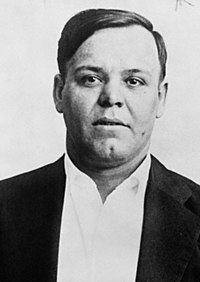Frank Gusenberg
This article includes a list of general references, but it lacks sufficient corresponding inline citations. (November 2012) |
Frank Gusenberg | |
|---|---|
 CPD mugshot of Frank Gusenberg | |
| Born | October 11, 1893 |
| Died | February 14, 1929 (aged 35) |
| Other names | Gusenberger Carl Bloom Howard Morgan Fred Gusenberg Frank Gold |
| Known for | Saint Valentine's Day massacre victim Contract killer Gang criminal Member of North Side Gang |
Frank Gusenberg (October 11, 1893 – February 14, 1929) was a German-American contract killer and a victim of the Saint Valentine's Day massacre in Chicago, Illinois.
Early life
Frank Gusenberg (akas: Gusenberger, Carl Bloom, Howard Morgan, Fred Gusenberg, Frank Gould) was the second oldest of three sons and one sister born to Peter Gusenberg Sr. Peter Sr. was a first generation emigrant from Gusenburg, a municipality in the Trier-Saarburg district, in Rhineland-Palatinate, Germany. Frank was raised at 434 Roscoe Street in Lakeview, Chicago. Frank followed his brother Peter Gusenberg into a life of crime with Bugs Moran. Frank was a polygamist and married two women, Lucille and Ruth, unbeknownst to them. He was first arrested for disorderly conduct in 1909 and from 1909 to 1914 was a suspect in numerous armed robberies and burglaries in the Greater Chicago area. In 1911, he was convicted of disorderly conduct and sent to the notorious Bridewell Prison in South Lawndale, Chicago.
In 1901 when Frank was eight years old, his elder brother, Peter, found their mother dead in the kitchen of their Roscoe Street home, leaving their upbringing to their father, Peter Sr., who was very much an absent father who was working all the time. Frank was later brought up on burglary charges by the state prosecuting attorney's office in 1926 but for some unknown reason the charges against Frank were never filed with the courts. His last known address was 5507 Beatrice Avenue in the Portage Park neighbourhood of Chicago, Illinois. After graduating from petty crime into more serious offenses, they teamed with Dion O'Banion, Hymie Weiss, and other members of the local mob scene. They became two of the gang's chief hitmen. After the O'Banion's 1924 murder, Gusenberg joined his friends, led by Hymie Weiss, in getting revenge on the Capone mob.
The Gusenberg Brothers and the Chicago gang wars
Frank Gusenberg participated in the gargantuan drive-by shooting in the North Side performed on Capone's headquarters, the Hawthorne Hotel in Cicero, Illinois, riddling it with thousands of bullets on September 20, 1926. According to many accounts, the second to last car stopped in front of the hotel restaurant where Capone was cowering and Frank's brother Pete emerged, clad in a khaki Army shirt, brown overalls, and carrying a Thompson submachine gun fitted with a 100-round capacity drum. Kneeling in front of the doorway, Gusenberg emptied the entire drum into the restaurant, and then casually strolled back to his car, which then sped off to safety.[citation needed]
The attack worked. Capone was very shaken and requested a sitdown between the two gangs. However, it failed. Hymie Weiss was murdered three weeks later, and over the next couple of years, the North Side Gang continued to weaken. The North Siders especially wished to kill Jack McGurn, as he was rumored to have been the machine-gunner who killed Weiss. On at least two occasions, the Gusenberg brothers made attempts on his life. Despite receiving several wounds, McGurn survived these attempts. Al Capone had Pasquale "Patsy" Lolordo installed as head of the influential fraternal organization Unione Siciliane. By late 1928, the leader of the North Side Gang, Bugs Moran, struck an alliance with Al Capone's rival Joe Aiello. The latter, assisted by the Gusenberg brothers, killed Antonio Lombardo and Pasqualino Lolordo, presidents of the Unione Siciliane. It was as a result of these murders that Capone plotted to eliminate Bugs Moran. [citation needed]
Final days
On February 14, 1929, members of the North Side gang gathered at a garage behind the offices of S.M.C. Cartage Company. Inside were Pete and Frank Gusenberg, Albert Weinshank, Adam Heyer, James Clark, John May, and Reinhardt Schwimmer (the latter two men not actually gang members). Five men, possibly members of Capone's Gang, possibly outside "hired guns", most likely a combination of the two, drove to the garage in a stolen police car. Two of the men, dressed as police, entered the garage, pretending they were conducting an ordinary raid, and lined Moran's associates up against the wall. Once the men's backs were all turned, facing the wall, two other men (with civilian clothes) entered the room with machine guns and, along with the "police", opened fire on the seven men, pounding 70 bullets into them in what would become known as the St. Valentine's Day Massacre.
When police arrived at the scene, Frank Gusenberg, being shot eight times, was the only victim still alive. He was taken to the Alexian Brothers hospital in Chicago, Illinois. When asked "Who shot you?" Frank, observing the gangland principle of "omertà" (absolute silence) replied, "Nobody shot me". Although the killers wiped out a large part of Bugs Moran's mob, they missed Moran himself. Some say that upon seeing the squad car, he drove past the garage he was planning on entering. Others say he was merely late arriving.[citation needed] http://www.myalcaponemuseum.com/id29.htm
In popular culture
- Frank Gusenberg would be portrayed in two movies about the era: Roger Corman's The St. Valentine's Day Massacre (1967) and Capone (1975)
- Gusenburg was inspiration for The Simpsons character Johnny Tightlips[citation needed] who does not give any information away, no matter how trivial.
- The video game Grand Theft Auto V features a version of the Thompson submachine gun known as the "Gusenberg Sweeper" as part of the Valentine's Day Massacre Special downloadable content. It is accompanied by a pastiche of the Cadillac 341 series (notoriously used by Al Capone) as well as 1920s mobster and flapper inspired clothing.
